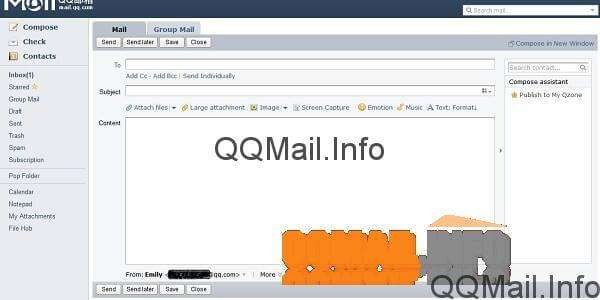
- How To Download Large File From Qq Mail
- How To Large File From Qq Mail To Pdf
- How To Download Large File From Qq Mail
- How To Large File From Qq Mail To Excel
- Large File Free
- Qq Mail Sign Up
- Qq File Download
Do you ever find yourself needing to send large files through Outlook but are restricted by the file attachment size limit?
You may have come upon an error message that says “Attachment size exceeds the allowable limit” or “The file you’re attaching is bigger than the server allows. Try putting the file in a shared location and sending a link instead,” depending on the Outlook version you’re using.
If you’re sending large image files you can automatically resize them to reduce their file size. Attach the images to your email message. Click File Info. Under the Image Attachments section, select Resize large images when I send this message. Jul 30, 2010 I was able to pack hundred of photos into one single 800 mB file, then downloaded by family members. More accurately, QQ.com provides free file transfer service. The files are presented as links for the recipients to download, so it does not require the recipients to have a qq mailbox for the same capacity. The total mailbox is 2GB. QQ International has advanced file transfer functions. You can send files or folders when you are online and even when you’re offline. Step 1: Send File/Folder Online. To send a file/folder, click on the “Send File” icon in the chat window and select “Send File” or “Send Folder” from the menu.
Yahoo Mail can perform the same trick, but it’s a less user-friendly option. If you try to send a large file through Yahoo, an alert prompts you to save the file to either Google. May 26, 2021 Yahoo Mail. Yahoo Mail can perform the same trick, but it’s a less user-friendly option. If you try to send a large file through Yahoo, an alert prompts you to save the file to either Google.
What is the Outlook file size limit?
Sadly, due to mail server restrictions, all versions of Outlook and Office 365 all have a default max attachment size limit of 20 to 25 megabytes (MB).
This limit makes it difficult to be productive — especially in the workplace because you’ll need to use a separate file transfer solution to deliver large files to your contacts. You might even need to bother your IT team for help. (Trust me, your IT team hates dealing with issues like this.)
If you want to solve this issue yourself, the internet lists many possible solutions to this problem:

- Uploading files via OneDrive and sharing the link
- Modifying the registry on Windows computer to increase the upload size limit
- Compressing files before sending
- Breaking up a file into chunks and sending multiple emails
While the above solutions will help you solve your problem, they’re inconvenient and require a lot of time just to send one file! You should be able to comfortably send large files directly from within Outlook. You should also be able to protect the files you share.
This is where TitanFile helps.
How to send large files through Outlook
We invite you to use TitanFile’s Secure Send add-in to easily bypass the file size limit and send large files in all versions of Outlook and Office 365.
In addition to being able to attach large files in Outlook, TitanFile also encrypts emails to ensure that no unauthorized persons or parties have access.
Here’s how to start sending big files in Outlook in just 5 minutes:
How To Download Large File From Qq Mail
1) Sign up for a free trial of TitanFile. (Don’t worry, no credit card is required)
2) Download the Secure Send add-in here and follow the installation instructions. With the add-in installed, you’ll see two new icons on Outlook’s navigation ribbon: “Attach Large File” and “Secure Send” as shown in the image below.
3 ) Add a contact, subject line, and message like you normally would.
4) Click the “Attach Large File” button to attach a file larger than 25MB, then wait for the file to finish uploading. You won’t have to wait long because TitanFile’s blazing-fast upload speed is capable of uploading gigabytes worth of files within minutes! (as long as your internet speed supports it)
5) Click the “secure send” icon to send an encrypted Outlook or Office 365 email to your recipient.
That’s it! Your recipient will now receive a link to access the files securely.
Now you can securely send large files to all your contacts, directly from Outlook. No need to resort to any other large file sharing method.
Found this solution useful? Share it below to show others how to attach large files to Outlook.
I had to deal with a “huge” mail.que file this morning and thought of letting you know how to handle similar issues.So, here is the scenario
- Came to know about this issue only when SCOM alerted for a low disc space
- On one of the hub transport servers, the mail.que file reached to 148GB (unbelievable)
A lil about the mail.que file:
The mail.que file temporarily stores all emails before it is delivered to the target. It is an ESE database which means it is similar in architecture like an Exchange mailbox database, the edb file.
As per a TechNet article
A queue is a temporary holding location for messages that are waiting to enter the next stage of processing. Each queue represents a logical set of messages that a transport server processes in a specific order. Queues exist only on servers that have the Hub Transport server role or Edge Transport server role installed.
Let’s take a look at the other files residing in this location:
Trn.chk – Checkpoint file like E0x.chk in exchange
Trn.log – The transaction log file which is getting committed now. Similar to E00.log in exchange
Trntmp.log – The next transaction log file which is created in advance.
Trnnnn.log – Next transaction log file created when Trn.log reaches its maximum size.
Trnres00001.jrs – First reserve log file. Only used when the hard disk drive that contains the transaction log runs out of space to stop the queue database cleanly
How To Large File From Qq Mail To Pdf
Trnres00002.jrs – Second Reserve log file.
Temp.edb – Temp database used to verify database schema on start-up.
Back to the issue:
How To Download Large File From Qq Mail
You need to know 2 important terms before we proceed since this issue could have caused due to a combination of both:
How To Large File From Qq Mail To Excel
- PipelineTracingEnabled: This is used for troubleshooting purposes and is not enabled by default.
- MaxDumpsterSizePerStorageGroup: This is for Exchange 2007. The maximum size of the transport dumpster queue per storage group. This is a universal setting for all storage groups; you can’t set variable sizes for each storage group. The recommended size is 1.5 times the maximum message size that can be sent. For example, if the maximum size for messages is 10 megabytes (MB), you should configure the MaxDumpsterSizePerStorageGroup parameter with a value of 15 MB. Read more here
You can use the cmdlet: Get-TransportServer | fl to get these details.
In my case, tracing was enabled and the dumpster was specified to be 50GB.
Large File Free
Enough talking and lets delete it now
Qq Mail Sign Up
This is the suggested way to get rid of the old mail.que file and get a new one without any downtime. I proceed under the assumption that you have multiple hub transport servers to process emails so, no emails will be processed at the time of this change. This
should take about less than a minute. I will call the Hub transport server HUB01. Remember that steps 6-8 are very important and will ensure none loses emails
Qq File Download
- Login to HUB01
- Open exchange management shell and run “Get-TransportServer ” HUB01″ |fl
- Here, look for PipelineTracingEnabled. This should be set to False. If not, run
Set-TransportServer HUB01 -PipelineTracingEnabled $False
MaxDumpsterSizePerStorageGroup is in MB’s and not GB’s
MaxDumpsterTime : 7.00:00:00
If not, run
Set-TransportConfig -MaxDumpsterSizePerStorageGroup <size> -MaxDumpsterTime <timespan>
- Now run “Get-Queue” and take a look at the count of messages in HUB01
- Goto services.msc and Pause the Microsoft Exchange Transport service
- Again, run “Get-Queue” and ensure all pending messages are “zeroed” out
- Once messages pending becomes zero, stop the Transport service
- Move the mail.que file and all others to a new folder in the same location
- Start the Transport service
- Take a look at the queue again
- You should see that messages would have started getting delivered
- Now you can backup or safely delete the old mail.que file
Ratish Nair
MVP Exchange
Team@ MSExchangeGuru
Keywords: Delete mail.que file, delete large mail.que file, mail.que file large in size, huge mail.que file in exchange, exchange 2007 mail.que file, mail.que file too big
Comments are closed.